Can you reinforce a dog’s fear by petting and talking to him when he’s scared?
In this post:
- Can you reinforce a dog’s fear by offering affection?
- How to reinforce appropriate behaviors.
- Why you should block inappropriate behaviors.
This topic was difficult for me to write about. I never did come up with a clear answer to the question, and I hope this post will be a place for honest discussion. I’d love to hear your thoughts in the comments.
Can you reward a dog’s fear by offering affection?
If only there were an easy answer!
I consulted with several professional dog trainers for this post, including Anthony Newman who runs Calm Energy Dog Training. He turned the question around and asked me what I thought. Here’s a summary of what I said:
It’s always worked to comfort my dog when his fear does not result in aggression. For example, when he’s scared of a tornado siren, he will curl up on his bed. This doesn’t bother anyone, so I will calmly pet and talk to him – or ignore him, which is probably not so nice! When aggression is involved, like barking at a stranger, I try not to give affection. I distract him and reward calm behavior.
After all my research for this post, this is what it comes down to for me. Offering comfort to a frightened dog is not going to do any harm. However, if the dog is showing inappropriate behaviors because of that fear – barking, pacing, growling – then we need to find a way to teach and reinforce a more appropriate behavior.
“We have to keep in mind that fear is an emotion, not a specific behavior,” said professional dog trainer Joan Hunter Mayer, owner of The Inquisitive Canine. We reinforce or punish behaviors, not emotions.
Newman also said fear will not be reinforced because reinforcement comes from giving a reward.
“A truly fearful, anxious dog in a high-trigger situation, like thunderstorm-phobia, simply won’t care about the cuddling,” he said. The dog won’t be able to experience it as a reward.
Why is this a tough topic?
One reason this topic is difficult for me is because we don’t all agree on how fearful dogs interpret our affection.
Professional dog trainer Ty Brown of Dog Behavior Online said he believes an owner’s affection can likely reinforce a dog’s fearful behavior because there is a disconnect in communication between the two species.
A great example of this is when a fear-aggressive small dog is barking and growling at strangers from her owner’s arms. Brown said he sees this a lot with little dogs.
“The dog is feeling fearful, and the owner is saying through voice and body language, ‘What a great job. That’s right. I support the state of mind you’re in,'” Brown said. “It’s a form of enabling and doesn’t teach the dog how to deal with that fear.”
I agree. Coddling a fear-aggressive dog will not help her build the skills she needs to deal with her fears in the future.
“It is important to remember in any dog training that dogs are not primates,” said professional trainer Rob Peladeau of Refined K9. Many of the things we do to help our children in fearful situations do not translate to the canine species.
Yet, some trainers say offering comfort could help a dog feel better in the moment, at least in some situations.
In her 2011 YouTube video “Calming A Fearful Animal,” professional dog trainer Suzanne Clothier said dog owners should offer affection to their scared dogs. But in order for that affection to be helpful, it needs to be quiet, firm and clear – not frantic.
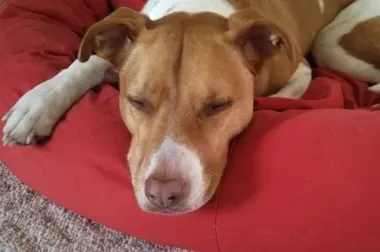
“Everything in my body language, my movements, my tone of voice, how I touch the animal, has to say, ‘I know that’s scary for you. I got your back here,'” Clothier said.
Brown also wants his clients to comfort their dogs whenever the dogs are scared or stressed, and he said the best way to do that is through structure.
“I want them to do it in a way that leads to growth on the dog’s behalf,” he said. “For example, a dog that is stressed by outside thunder could be best soothed by being given a command to lie in a bed and stay put.”
This is typically what I do with Ace, and once he is in a calm state, he is able to receive affection as a reward for his calm behavior. While there are different ways to offer comfort to our dogs, the long-term goal should be to figure out how to get rid of the dog’s fear or help him learn to deal with that fear.
How to reinforce appropriate behaviors.
I always try to reinforce the behaviors I want from my dog, no matter what state of mind he’s in. This is especially important when aggression is involved, no matter how minor.
For example, my dog gets scared when strangers approach us in certain situations. He responds by barking, and this is a behavior I generally don’t want to reinforce.
I can reassure my dog with affection all I want – “It’s OK. It’s OK.” This may or may not affect my dog’s emotional state, but it’s not going to stop the unwanted barking. I know him well, and while he may bark less, he’s still going to bark.
Ace will stop barking, however, if I calmly put him in a down/stay position and ask him to focus on me – “watch.” His brain has to focus on something other than being scared – obeying my commands. I prefer not to use treats, but if treats bring out the behavior I’m looking for, then so be it! All I care about in that moment is reinforcing the right behavior.
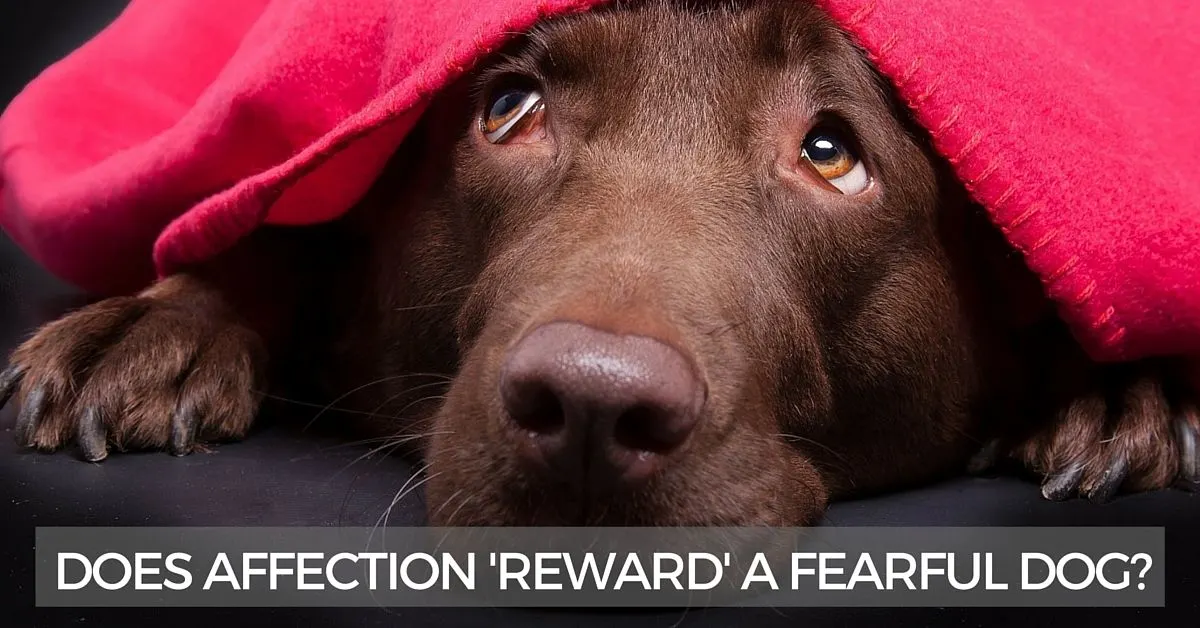
Dr. Patricia McConnell, a certified applied animal behaviorist, wrote a post on her blog about how you can’t reinforce fear through affection. One of her examples is when a fearful dog is barking at visitors. She wrote that if the “strangers” toss treats at the dog, the treats would not “reward” the dog’s fear. Instead, the treats would actually decrease the fear, which would eventually help the dog change his behavior (I love treats! Strangers bring treats! I love strangers!).
Do you see how both these approaches could help a dog? It all depends on the individual dog, the unique situation and the owner’s consistency.
Why you should block inappropriate behaviors.
Another factor – regardless of whether or not we give affection – is that a dog’s own actions can actually make the dog feel more fearful, according to McConnell in the comment section of the same post.
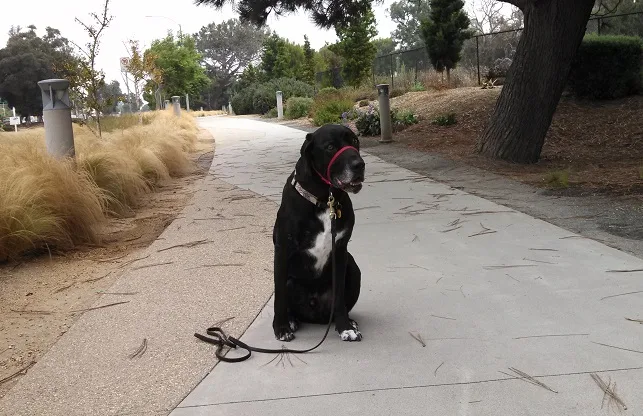
For example, if the dog is lunging and barking at a stranger, the lunging and barking and getting worked up could make the dog feel more afraid. This is why it’s so important to prevent, block or stop these types of behaviors. Then, teach and reinforce “good” behaviors such as sitting quietly.
Emotions are contagious.
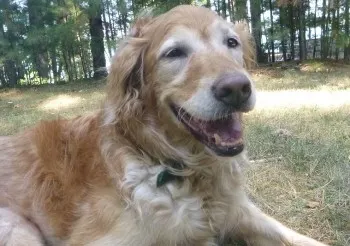
If I want my dog Ace to be calm, the first thing I need to do is be calm myself.
If Ace is scared of an approaching stranger, and I choose to frantically pet my dog while repeating “It’s OK! It’s OK!” while we run away, what am I communicating to him? I’m telling him, “I’m scared, and you better be scared too!”
Isn’t this the perfect example of how our affection can actually make a dog more fearful? I think so, but I’ve love to hear what you think. At the very least, it’s not going to help the dog feel any less afraid.
How else can dog owners help their fearful dogs?
- Don’t punish a fearful dog. Instead, distract the dog and then reward him for appropriate behaviors.
- Provide the dog with lots of exercise. Dogs with less energy are generally going to be less reactive.
- Build your dog’s obedience skills so he’ll have more self-control and a greater ability to pay attention to you.
In going through a list of all fears and anxieties, Brown said he can generally find obedience behaviors that:
- Bring structure and are calming.
- Achieve focus on the owner and therefore send focus away from the source of the stress.
- Lend a sense of leadership which is needed when a dog is feeling nervous.
“For that reason, we always put a lot of emphasis on advanced obedience with all of our clients,” he said.
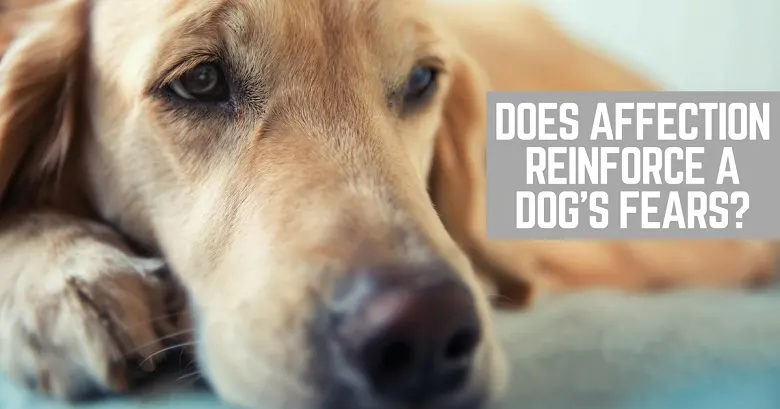
What do the rest of you think? Are there situations where affection can reward a dog’s fears?
Let me know in the comments!
Related posts:

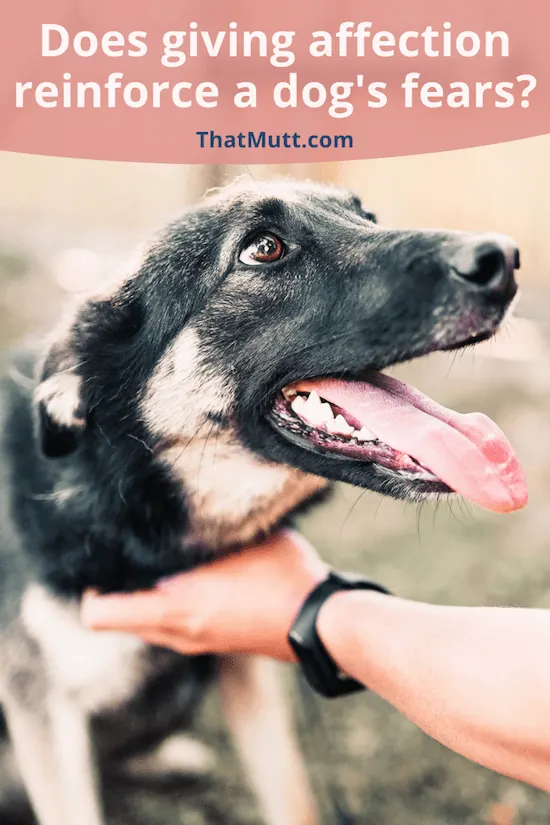
Cheryl
Sunday 26th of June 2022
Lindsay I have 2 dogs, both rescues. Sophie’s mellow loves everyone, in 10 years has yet to meet a stranger. Zeke my more recent rescue loves people, adores kids! But has a bite history. I fostered him a year, he had no takers, and after watching peoples eyes glaze over when he had just been happily giving them kisses, but learned of his history, I decided to adopt him.
The only time he’s really shown aggression was when I had to leave him at the vets for dental cleaning. Even then from what I heard sounds like it was when she reached for him to take him out of the cage to bring him out.
What is the best way to reprogram him, so to speak, not to bite or snap but alternative reactions. At home and on walks he has yelped when scared. Live in a condo complex and he hasn’t snapped at anyone.
Lindsay Stordahl
Monday 27th of June 2022
Hi Cheryl, sorry to hear your dog tries to snap at times but that's great it is very rare and in a few specific situations. I do not think it's a good idea for me to give you a plan without knowing the details. I would definitely reach out to a local trainer for help. My thought is it might be a barrier issue, in this case the crate as a barrier. Maybe takes notes on whenever he shows any aggression so you can notice patterns. I know my weim will sometimes nip as I'm closing his crate door. I worked through this by tossing him a treat as he went in his crate, then another as I closed the door and another after the door was closed. You might try something like that. Toss a treat before you open the kennel door, then toss another. Than another as he comes out. You can use that process with other barriers too, such as doors or gates if you ever notice an issue there. Good luck, sounds like a nice dog overall!
Andy M, DVM
Sunday 26th of June 2022
Like Lindsay, I never worried much about fireworks and thunder till I had a fearful dog. Now I'm not afraid to use trazodone. If it doesn't sound like a war zone, though, I find trying to act as if it were no big deal is more effective than empathizing and excessive cuddling.
Lindsay Stordahl
Monday 27th of June 2022
Yes, that's what I try to do too. If it's just a few fireworks, I ignore it and try not to respond. And I do use trazodone for my weimaraner now as well. We give him that on New Year's Eve and the 4th of July.
Anna
Sunday 19th of June 2022
I have heard this so many times and it has wracked me with guilt/anxiety ever since becoming an owner of a fireworks-phobic dog. However, I have found my dog looks to me for comfort... In similar distressing circumstances, he has comforted me; literally finding me if I am upset/distressed, licking at my tears etc. So in his way I believe he seeks this reassurance. He is also anxious around some dogs and from a puppy he has stood on his hind legs and wrapped his front legs around my leg. Proof has been in his behaviour. And since being close/touching me and sleeping in the bed with me (he doesn't usually) during fireworks he sleeps so soundly he dreams and snores! I agree this is different from his occasional barky behaviour towards other dogs. I believed that this was causing him stress/distress so we learned "leave"/ distraction methods to avoid this stressful behaviour. I think as you said it is more complex than implied. It depends on dog breed/size/personality/response. After stressing for years about the right/wrong way to approach it, I have learnt to be more instinctive: what works for us/him. I think like other areas of life there is no hard or fast right or wrong. It is what works for you within all your circumstances/parameters. Thanks for another great article.
Lindsay Stordahl
Monday 20th of June 2022
Such good points and I'm so glad that offering comfort does seem to have helped your dog a lot!
Mary Sue Brown
Tuesday 23rd of March 2021
Hi Lindsay- I think a factor to consider is why your dog harbors certain fears & anxieties. We’ve had two rescue goldens with extreme fears. The year old female was terrified of thunderstorms; she’d been on her own for weeks after she was abandoned & probably had been caught in the severe thunderstorms we got in Texas. The second, a male, had separation anxiety- had been adopted & given up by 3 owners by the time he was 2; he was left by himself all day, every day, when they went to work; they didn’t understand why he got into mischief when he was home alone. Both of these dogs were very sweet, but they experienced trauma and/or insecurity & lack of affection at a young age; we felt their fears were a reasonable result of their early experiences & we didn’t hesitate to offer comfort & reassurance when they exhibited their anxiety & fear. They both grew into loving, wonderful, well-adjusted pets, and we loved them dearly. Mary Sue
plantskidsdogs
Thursday 2nd of July 2020
I've rehabilitated terrified and feral dogs for 20 years. In the beginning I believed we shouldn't reward the behavior by paying any attention to it. I have personally come 180 degrees in this view. I think much has to do with HOW you treat the dog who is storm terrified, panting, pacing, and quite upset. I've found that first we need to have bonding time when they are NOT scared, where I massage them nightly for 30 minutes. Sometimes I hum or simply talk in a low soothing voice. Starting massages when they are not scared, teaches them I am their "safe" place/person. Uniformly, they will all then find ME when there's a storm coming. I believe medication has a strong place in their treatment, especially for storms we know may go on for hours or all night. If it's a tiny one, I usually forgo medication to use it as a positive time they can learn from. When they come to me during a storm, I will use the same low comforting voice and massage they have had when it's not storming. Massage releases oxytocin which is a "feel good" bonding hormone. Thus it works for storms too. Do they stop panting 100%? No, but being their safe person and massaging (and maybe humming, or talking soothingly to them during a storm) has never made them worse. It has always improved their storm tolerance. In addition, it improves their trust and learning in general training, especially with other items they are afraid of. I do give them leeway. This means if they come and lay next to me, I will massage. If they chooses to get up and pace, I let them de-stress with movement. Usually, they'll chose to come back to me of their own choice. As long as they are not a danger to themselves or digging through a wall, I won't crate. I stress I am always calm with them. If an owner is anxiety prone or upset by the dog's behavior, they WILL make the behavior worse, no matter what they do IMHO. What I see uniformly over time, is a reduction in anxiety levels. I've had dogs that were so terrified they needed special crates to contain them. By using nightly massages all have been able to be out in the house when it's storming, but all will come to me as their safe place. Some have progressed enough to simply pant mildly in storms, which is usually an 80-90% improvement. I'm aware that many find this behavior upsetting or unacceptable. I would comment that my storm scared dogs and timid dogs are simply more sensitive dogs. They are still dogs that respond to training. The positive side to them is they are very loyal, strongly bonded dogs, who make loving family dogs. The positives strongly outweigh the negatives and they do improve over time with work.